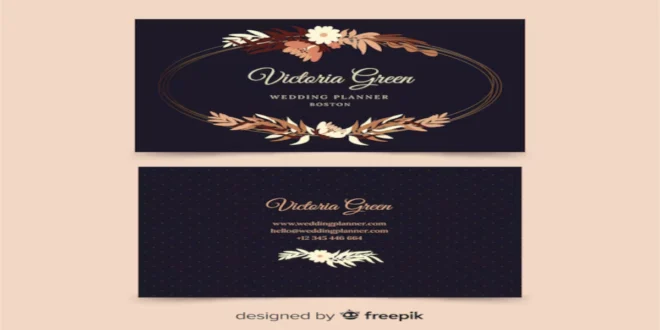How to Design a Respectful and Memorable Funeral Home Business Card Design
In the funeral industry, the first impression often counts more than in many other fields. A well-designed business card for a funeral home does more than just convey contact information; it sets the tone for a respectful, compassionate, and professional approach to end-of-life services. Business cards have long been a traditional way for professionals to offer quick access to essential information, but for a funeral home, this small piece of paper carries a unique significance.
This article will provide insights into designing a funeral home business card that captures the essence of compassion and professionalism. By balancing design elements, font choices, color palettes, and images that resonate with a sense of dignity, funeral homes can create business cards that make a lasting impression.
1. Understanding the Purpose of a Funeral Home Business Card
A funeral home business card is more than just a method of contact; it is a small but powerful representation of the funeral home’s values, professionalism, and commitment to compassionate service. This card has the unique role of conveying sensitivity while building trust and establishing the funeral home as a reliable, caring resource for families. Let’s delve into the key purposes that make a funeral home business card essential.
1.1 Brand Representation: Conveying Identity and Values
In an industry where compassion, empathy, and dignity are paramount, a funeral home’s brand identity must communicate these values clearly. A well-designed business card acts as an extension of the funeral home’s brand, visually and emotionally reflecting its mission to provide caring, respectful service.
By choosing elements like a dignified color scheme, professional fonts, and tasteful design features, the card subtly communicates the funeral home’s commitment to quality and compassion. This brand representation is especially important because, in a sensitive industry, families and loved ones seek businesses they can trust during difficult times.
1.2 Contact Information: Easy Access in Times of Need
Clear and accessible contact information is essential on any business card, but it holds particular importance for a funeral home. During times of loss, families need reliable access to essential contacts, often without delay. A funeral home business card should include all relevant information: phone numbers, email addresses, physical location, and any website links. Each point of contact should be easy to find on the card, laid out in a clean, readable format that helps families connect with the funeral home without added stress.
Including a website link or QR code can be especially helpful, allowing clients to easily access the funeral home’s services, resources, or additional information with a quick scan or click.
1.3 Building a Lasting Connection with Families
Unlike many other business cards, a funeral home card often serves as a keepsake. Families may hold onto it for years, revisiting it when the need for services arises or when referring others to the funeral home. Because of this, the card can play a unique role in maintaining a lasting connection with clients. By keeping the design professional, tasteful, and sensitive, the card reflects the values of the funeral home and reminds families of the caring support they received during a challenging time.
For families, having a tangible card can also offer comfort. It represents a trusted contact, often held onto as a form of reassurance, especially during anniversaries or other times when the funeral home’s services may be called upon again.
1.4 Creating a Memorable, Sensitive Design
In a field that requires exceptional sensitivity, design plays a critical role. A funeral home business card should not only be informative but also visually respectful. Design choices should avoid being overly flashy or decorative, instead opting for a subtle elegance that conveys empathy and professionalism.
Through thoughtful color palettes, minimalist layouts, and tasteful symbols (such as a small dove or a nature-inspired element), the design can evoke a sense of calm and reassurance. This careful attention to design not only makes the card more memorable but also reinforces the funeral home’s reputation as a compassionate, dignified provider of end-of-life services.
1.5 Reassurance and Professionalism in a Small Format
Ultimately, a funeral home business card is a silent ambassador of the business’s professionalism. It provides reassurance to families by conveying a level of respect, empathy, and readiness to assist them in their time of need. Each design element – from the font to the choice of paper – contributes to a feeling of trustworthiness, encouraging families to rely on the funeral home when they need it most.
Summary
A funeral home business card is much more than a marketing tool; it is a thoughtful extension of the funeral home’s identity. It offers essential contact information, establishes a lasting connection, and provides families with a quiet sense of support. Through carefully chosen design elements, the card becomes a symbol of the funeral home’s commitment to honoring and helping families with compassion and dignity, making it an essential part of the business’s outreach.
2. Key Design Principles for a Funeral Home Business Card
2.1 Keep It Simple and Respectful
A funeral home business card should have a clean, simple design that is easy to read and feels respectful. Simplicity ensures the card doesn’t feel overcrowded or overwhelming. This can be achieved through:
- Minimalist design elements, such as a muted logo or emblem.
- Clean, organized layouts with plenty of whitespace.
- Limited use of bold graphics or overly bright colors.
2.2 Choose a Dignified Color Palette
Color is a powerful tool in evoking certain emotions and tones. For a funeral home business card, colors should evoke calmness, respect, and compassion. Popular colors for these cards include:
- Soft Blues: Associated with trust, calmness, and peace.
- Greys and Whites: Neutral colors evoke a sense of formality and professionalism.
- Earth Tones: Colors like soft browns, greens, and creams give a natural and grounding effect.
- Black and White: Timeless and formal, black and white can offer a classic and somber look that’s fitting for a funeral home.
3. Key Elements to Include on a Funeral Home Business Card
3.1 Contact Information
The main purpose of a business card is to share contact details, so it’s crucial to include all essential information:
- Phone Number: It should be easily accessible and prominently displayed.
- Email Address: Ensure it’s a professional email, such as one associated with the funeral home’s domain.
- Physical Address: Clients often need to locate the funeral home, so a complete address is helpful.
- Website URL: If the funeral home has an online presence, include the website link.
3.2 Logo and Tagline
If the funeral home has a logo or tagline, these should be featured on the card. The logo should be appropriately sized, not overwhelming the card’s layout but still being noticeable. The tagline should be brief and meaningful, such as “Compassionate Care in Your Time of Need.”
3.3 Professional Titles and Credentials
Professional titles and certifications are valuable for building trust. If there are licensed funeral directors or specialized grief counselors on staff, include their names and credentials. This can reinforce the funeral home’s commitment to professionalism.
3.4 Social Media Icons
For funeral homes with a presence on social media, consider adding small, unobtrusive icons to the card. However, they should not overpower the card’s design, as the primary focus is on the direct contact information.
4. Font and Typography Choices
Choosing the right font is crucial for readability and tone. Fonts convey subtle messages about professionalism, sensitivity, and elegance. For a funeral home business card, consider these points:
- Serif Fonts: Traditional and formal, serif fonts (like Times New Roman) are often perceived as more professional.
- Sans-serif Fonts: Clean and modern, sans-serif fonts (like Arial or Helvetica) offer a fresh but respectful look.
- Avoid Decorative Fonts: Avoid overly stylized or decorative fonts, as they can detract from the card’s respectful tone.
- Font Size and Spacing: Ensure text is easy to read by using a minimum font size of 10pt. Appropriate line spacing helps avoid a cluttered appearance.
5. Imagery and Symbols
Imagery can enhance the tone of the business card, but for a funeral home, any images should be carefully chosen to avoid being too intense or emotionally heavy. Appropriate images include:
- Doves: Symbolize peace and purity.
- Nature Elements: Trees, leaves, and water elements often represent tranquility and the cycle of life.
- Simple Iconography: A subtle cross, heart, or candle can add a meaningful touch without overwhelming the design.
6. Material Choices for Funeral Home Business Cards
The type of paper and printing finish can significantly impact the impression a business card makes. For funeral homes, the following material choices are often the most suitable:
- Thick, High-Quality Paper: A sturdy, quality paper stock gives a sense of reliability.
- Matte Finish: Matte finishes feel smooth and offer a more understated, professional look than glossy options.
- Embossed or Foil Accents: These add a touch of elegance without being too flashy. Consider embossing the logo or using a foil accent for the business name.
7. Unique Touches to Stand Out
Adding unique, subtle touches can help the funeral home’s business card stand out while still being tasteful. Ideas include:
- Rounded Corners: Rounded edges can soften the card’s appearance.
- Texture or Raised Printing: Adding texture can give a luxurious feel to the card.
- Memorial Quotes: A small, meaningful quote about remembrance or peace can create a comforting sentiment for recipients.
8. Digital Business Cards: A Modern Alternative
Digital business cards are growing in popularity, even within traditional industries like funeral services. These cards are accessible on mobile devices and allow for easy sharing and updating of information. Benefits include:
- Instant Accessibility: Clients can quickly save contact information directly to their phone.
- Interactive Features: Links to websites, social media, or video resources.
- Eco-Friendly: No paper waste, which can be an appealing choice for eco-conscious clients.
9. SEO-Optimized Digital Versions of Business Cards
For those looking to promote funeral services online, consider optimizing the digital version of your business card for search engines. This can be achieved through a well-designed website with optimized images of your business card, ensuring that contact information is searchable.
- Optimized Image Alt Tags: Include alt tags with keywords like “funeral home business card” and “funeral services.”
- Local SEO Keywords: Include location-based keywords on the card image file names, such as “Funeral-Home-Business-Card-New-York.”
10. Example Layout Ideas
10.1 Classic Layout
A classic layout typically positions the funeral home’s logo at the top center, with the contact details neatly aligned underneath. The font is often serif, and the overall look is symmetrical and clean.
10.2 Contemporary Layout
A contemporary layout may use a sans-serif font, with contact information aligned on the left and the logo on the right. This layout feels modern and can appeal to clients looking for a fresh approach.
10.3 Portrait Layout
Using a vertical or portrait orientation is unconventional, but it can set a funeral home’s card apart while still feeling respectful. This orientation also allows for a unique placement of elements, such as a vertical line separating the logo and the contact information.
Conclusion
A well-designed funeral home business card is a balance of respect, professionalism, and subtle distinction. With the right choice of colors, fonts, materials, and layout, a funeral home can create a business card that leaves a lasting impression of compassion and trust. By considering the unique sensitivities of the funeral service industry, businesses can create cards that resonate deeply with families and convey the dignity and care they offer.
In today’s digital age, the combination of a physical and digital business card can enhance reach and convenience. With attention to design and detail, a funeral home business card can truly become more than just a contact card—it can serve as a symbol of the dedicated service and care offered during life’s most challenging moments.
Frequently Asked Questions (FAQs)
What are the essential elements to include on a funeral home business card?
Answer: A funeral home business card should include essential contact information like phone number, email address, and physical address, along with the business logo, tagline, and any relevant professional titles. It may also have a website link and subtle social media icons if applicable. Keeping the design clean and respectful ensures a professional yet compassionate impression.
What colors work best for a funeral home business card?
Answer: Soft, muted colors are often ideal for a funeral home business card. Calm tones like soft blues, grays, earthy browns, or even a classic black and white palette evoke feelings of respect, peace, and professionalism. Avoid overly bright or flashy colors, as they can feel inappropriate in the context of funeral services.
Should funeral home business cards have images or symbols?
Answer: Simple, meaningful symbols can enhance a funeral home business card without overwhelming it. Doves, nature elements, or small, subtle icons like a cross or candle are commonly used to evoke a sense of peace and remembrance. The goal is to maintain a respectful, tasteful design without overpowering the essential contact information.
What type of paper is best for a funeral home business card?
Answer: High-quality, thick paper stock with a matte finish is often best for funeral home business cards. This choice lends a smooth, professional feel, offering a more understated look than glossy finishes. Subtle touches like embossing or a slight foil accent can add elegance without appearing flashy.
Are digital business cards suitable for funeral homes?
Answer: Yes, digital business cards can be a modern and convenient option for funeral homes. They offer easy sharing, instant accessibility, and eco-friendly advantages. Digital cards also allow interactive features, such as direct links to a website or email, making it simple for families to reach out when needed.
How can I make a funeral home business card stand out while still being respectful?
Answer: To create a unique yet tasteful funeral home business card, consider subtle design touches such as rounded corners, soft textures, or a meaningful quote about peace or remembrance. These additions can make the card memorable without detracting from its respectful tone, helping to convey a sense of compassion and professionalism.
READ ALSO: Business for Sale in Sunshine Coast: A Complete Guide to Opportunities, Growth, and Success
 Touch Blog
Touch Blog



